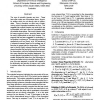Free Online Productivity Tools
i2Speak
i2Symbol
i2OCR
iTex2Img
iWeb2Print
iWeb2Shot
i2Type
iPdf2Split
iPdf2Merge
i2Bopomofo
i2Arabic
i2Style
i2Image
i2PDF
iLatex2Rtf
Sci2ools
IJCAI
2003
2003
Coherence of Laws
The core of scientific theories are laws. These laws often make use of theoretical terms, linguistic entities which do not directly refer to observables. There is therefore no direct way of determining which theoretical assertions are true. This suggests that multiple theories may exist which are incompatible with each other but compatible with all possible observations. Since such theories make the same empirical claims, empirical tests cannot be used to differentiate or rank such theories. One property that has been suggested for evaluating rival theories is coherence. This was only understood qualitatively until we [Kwok, et.al. 98] introduced a coherence measure based on the average use of formulas in support sets for observations. The idea was to identify highly coherent theories with those whose formulas that are tightly coupled to account for observations, while low coherence theories contain many disjointed and isolated statements. Our current approach generalizes that insight...
| Added | 31 Oct 2010 |
| Updated | 31 Oct 2010 |
| Type | Conference |
| Year | 2003 |
| Where | IJCAI |
| Authors | Rex Bing Hung Kwok, Norman Y. Foo, Abhaya C. Nayak |
Comments (0)

